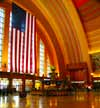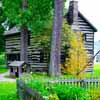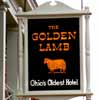Southwest Ohio is mostly gently rolling hills and fertile topsoil. The area is highlighted by Cincinnati, the Queen City of the West. Other major metro areas include Dayton, Springfield, Chillicothe and Portsmouth. Southwest Ohio was home for the Wright Brothers. four of Ohio's presidential sons, Harriet Beecher Stowe (author of Uncle Tom's Cabin) and the cradle of the Underground Railroad in Ohio.
Just north of Springfield, is a slice of land called Cedar Bog. The area is continually fed by natural springs. That area has been preserved and looks much as it did right after the last ice age including plants that can only be found here.
Running down the center of the state is the Scioto River, a major waterway used by Native Americans and early Ohio settlers. Each year that area is explored by bicycle on the Tour of the Scioto River Valley (TOSRV) by thousands of bicycling enthusiasts come from all over the country to pedal the 105 miles from Columbus to Portsmouth and back again in all kinds of unpredictable weather.
 Cincinnati
Cincinnati
Perched high on the banks of the Ohio River so to avoid the yearly floods, Cincinnati experienced spectacular growth during its first 40 years. By 1820, citizens, extremely proud of their bustling city, were referring to it as The Queen of the West. With the introduction of the steam boat, Cincinnati really took off. Not only did this enable local farmers to get their crops to markets along the Ohio River, but it also allowed all sorts of industries to sprout up in Cincinnati that could then be shipped world-wide. With so much river traffic, demand was high for steam boats and because of its central location, plentiful raw materials, Cincinnati became a builder of steam-powered boats. In fact, at the high point of river steam boats, more than 1/4 of all of them were produced in Cincinnati.
Today, Cincinnati is home to Proctor & Gamble, the Cincinnati Reds, the Bengals, numerous banks, and is known across the country for its famous chili concoctions. It is a lively city, steeped in tradition, but with an eye for the future.
Read more about Cincinnati 
 Union Terminal
Union Terminal
The terminal was designed to accommodate 216 trains daily and service approximately 17,000 people. During the last World War, the distinctive station doubled that capacity without missing a beat. Visiting the distinctive art deco station is like stepping back in time. Inside the huge cavernous terminal it's not hard to imagine what it must have been like. Most all of the decor in the station has been saved and restored, with special emphasis on new exhibit space that once house shops and offices around the perimeter of the semi-circular structure.
Read more about Cincinnati's Union Terminal 
 Carillon Park in Dayton
Carillon Park in Dayton
Carillon Historical Park showcases Dayton's rich heritage of creativity, invention, and milestones in transportation that changed the nation and the world. Founded by Colonel Edward and Edith Deeds, the Park is situated on a beautiful 65-acre campus.
The park shares the region's history from its founding in 1796 through the important local contributions made during World War II. Visitors learn about these achievements while strolling through the Park's 25 historical buildings and interacting with hundreds of artifacts and exhibits. Among them is the 1905 Wright Flyer III, the world's first practical airplane developed by the local Wright Brothers.
Read more about Carillon Park in Dayton 
 National Museum of the USAF in Dayton
National Museum of the USAF in Dayton
The National Museum of the United States Air Force features the full gamut of flight. Located at Wright Patterson Air Force Base, the museum is a must see for anyone with an interest in flight.
The museum presents military aviation history in a gallery format, with over 400 aircraft on display in this free to the public museum. See all sorts of air craft from the beginning of manned flight, up through space travel. Not to miss is the special display for Air Force One.
More about the Air Force Museum in Dayton 
 Chillicothe Mound City in Chillicothe
Chillicothe Mound City in Chillicothe
Although the Chillicothe earthworks were surveyed in the early 1800s, excavations of the mounds were not formally started until the 1840s. More mounds were dug into in the late 1890s and again in the 1920s. Much of the information gained from these excavations is used today to better understand the Hopewell Culture. Some of those artifacts are on display at the Hopewell Cultural National Park Center. Sadly though,most of the artifacts were taken to other museums around the world. The Chillicothe Cultural Center gives an excellent presentation of the mound-builders, some of the mounds they constructed on this pre-historic site, and the ability to walk the grounds the same mound builders walked 1000 years ago. While ph9otographs provide a glimpse of the earthworks, it's not until you actually walk the grounds that you can appreciate the true scale of their efforts.
More about Mound City National Park 
 Lebanon
Lebanon
It was at the crossroads connecting Cincinnati and Columbus to the north and Chillicothe and Dayton to the west that made this a natural spot to build a town. In 1802 the community was organized. Lebanon has been called the Cedar City because of the eastern red cedar trees growing in the area. The trees were growing in such abundance it was only fitting to name the new town Lebanon, Ohio, after the country of Lebanon where there are similar cedars growing. Lebanon is the home of Ohio's oldest operating inn, the Golden Lamb which has been a long time favorite of traveling dignitaries and celebrities. Lebanon is also known for it large number of antique stores, local scenic railroad, and their annual lighted Christmas Carriage Parade.



